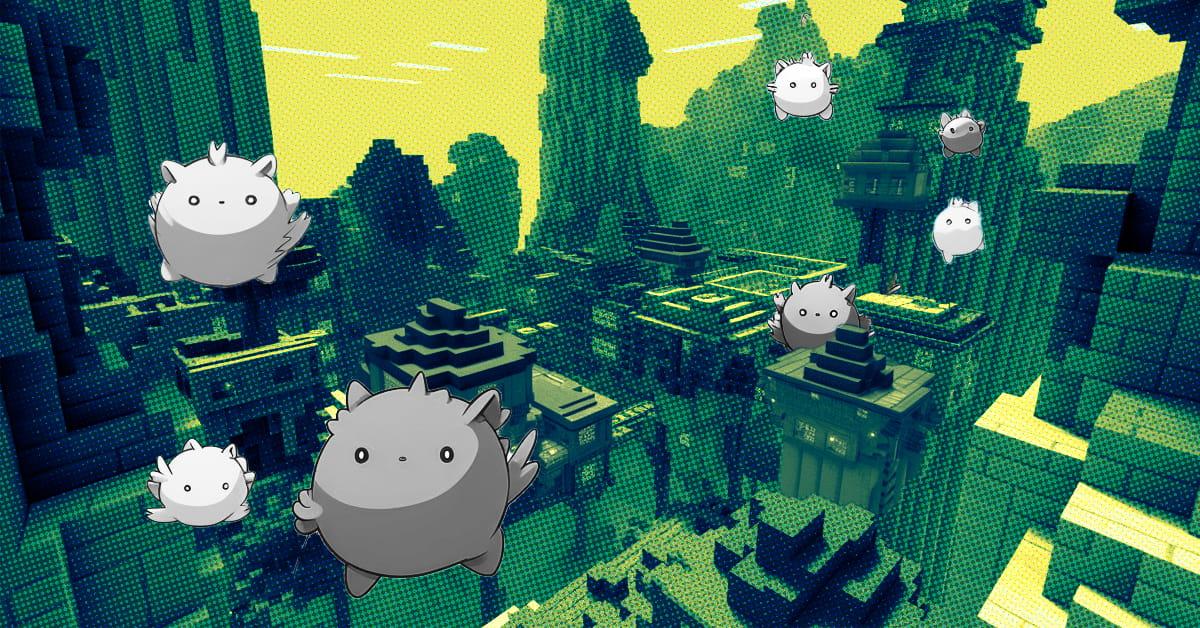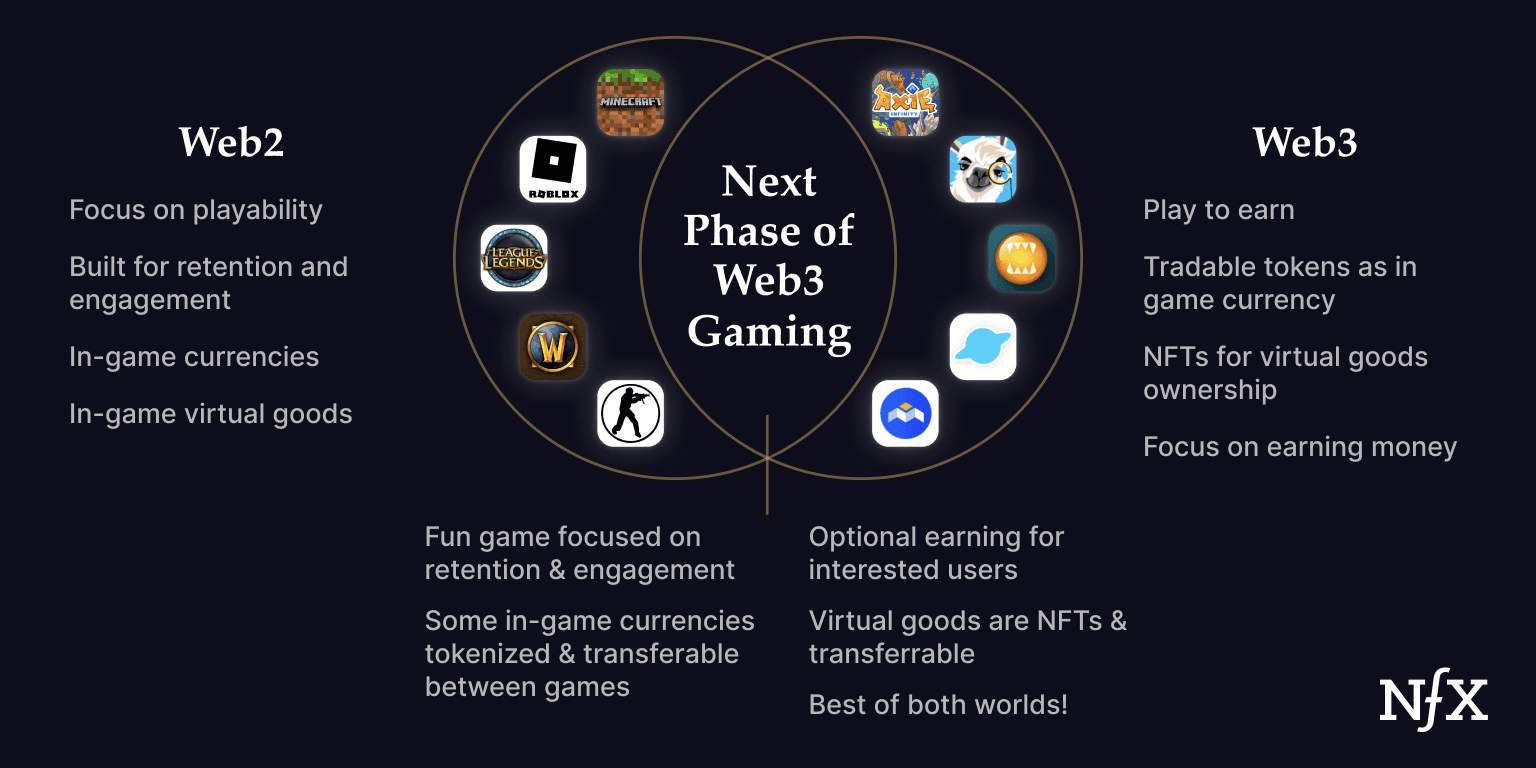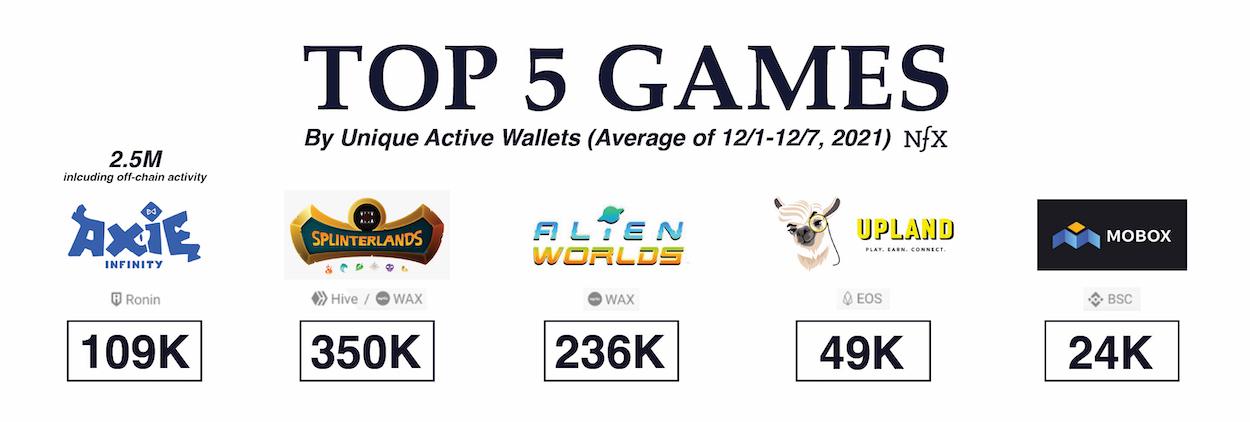

The crypto drumbeat for more than a decade has been: “Out with the Old Guard, in with the New.”
It makes sense. Looking at the big picture, the 2008 financial crisis was triggering. People called for a new global reserve currency which not only spawned a cultural movement, but also an entirely new financial system with DeFi. Bitcoin and web3 in particular sparked a movement to overturn existing centers of power.
Today, this revolutionary spirit is still what animates the web3 space. It attracts Founders, developers, and users to exciting new projects, the main ones being in NFTs, DeFi, DAOs, and Web3 Games.
But believing that all of web3 should be revolutionary is a logical fallacy. It proposes a false dichotomy: one way or the other, take it or leave it. When actually, to succeed, many web3 projects must be evolutionary, not revolutionary. They must take the best from the before-times and make it even better. This is especially true of web3 gaming.
We are in the first wave of web3 games. Right now, we’re seeing many of them focused on play-to-earn. They’re mostly about the money instead of prioritizing fun and engaging gameplay. If web3 gaming remains tuned in this way – focused on those looking to earn rather than play – then we fear it will never be mainstream and many projects will fail.


We believe that for web3 gaming to succeed, it needs to build on top of the best of web2 gaming. Leaders in web2 games are some of the best entrepreneurs we’ve ever seen at building products, creating engagement, and overall understanding user psychology. Web3 games projects today would be wise to embrace the product psychology that made games so meaningful and enjoyable in web2 – before earning money was a primary incentive for some users.


The winning strategy, we believe, is to evolve what worked well in web2 games with the awesome new capabilities and concepts of web3. A new wave of games doing just this is around the corner and could change gaming forever.
Web3 Gaming Is On The Rise
Web3 gaming is on the rise. Gaming accounted for a massive 49 percent of blockchain usage in 2021. Last year saw more than 1.4M active wallets connected daily to blockchain-based games, making it the most used category, even ahead of DeFi.


Source: DappRadar, the top 5 games by active wallets (as of December 2021)
Growth has continued in 2022. Web3 games attracted 1.22M unique active wallets in March 2022, accounting for 52% of blockchain activity. There’s a reason my partner Morgan Beller says games are the gateway to onboarding net new users into web3.
While these numbers are still tiny in comparison to web2 games – with more than 3 billion players in 2021 – as growth continues to increase, the stakes are only getting higher.
The early #1 in this space, Axie Infinity, has received a lot of attention and criticism, especially after hackers carried out a costly $620M breach to their network. Axie has lost a lot of traction since the hack, but they’re still hard to ignore. It’s the 4th most valuable dApp year to date with total revenue at $1.3 billion. However, they’ve dropped to 8th in the last 6 months and they’re not even ranked in the past quarter. What many don’t realize is that most of this decline happened before the hack, which prompts the question: why?
The Risks of Prioritizing ‘Earn’ over ‘Play’
Axie Infinity has clearly done incredibly well, but there are still cautionary lessons to be learned. Yes, the hack slowed growth. But there are other considerations that you need to keep in mind if you’re using the play-to-earn model. Sky Mavis, the developer of Axie Infinity, created a compelling gameplay experience, but the real draw to users has been its potential economical benefits.
At some point, players have earned up to $1,000 per month from playing full-time, which is a good living wage in many developing countries. Playing Axie has actually emerged as a new job in the Philippines, which is where over 40% of Axie’s users live. But game developers need to carefully design for sustainable in-game economies, and get ready for periods where most users will not be able to earn in the game, or such success will be short-lived.
We see cases where people pay a lot to buy into the game. Axie’s NFT marketplace is selling in-game assets (i.e. Axies) for an average of $787.
Right now, new users are driving demand for the in-game assets, but as the percentage of new users compared to total users decreases (which eventually will happen in any game), they’ll need to find other sources of demand to support current prices. Any chance of sustaining demand will come from increasing in-game engagement and activity with existing users. Without such engagement-based demand not only will users not earn a living from the game, but they will actually lose their investment.
Web3 gaming can’t sustain itself as just a pay-to-play revolution. In short, web3 needs to support great games.
Here are a few principles of how to build the best web3 games.
Evolutionary Principles of Gaming 3.0
To start with, one needs to embrace the concept that web3 games are an evolution on top of the success of web 2 games, and not a revolution that can disregard all past principles. This is the basic principle we believe will be shared between all successful web3 games.
We believe that the core of web3 games is about power shifting back to the users. The nature of virtual goods and in-game currency is changing from who owns them, what you can do with them, and how much money you can make from them.
Virtual goods and in-game currency being stored on-chain is a major change for game developers, but it’s an even bigger deal for the users, with fundamental changes to the ownership of in-game achievements, items, and tokens.
We believe nearly every successful game in the future will promote these principles, which – if implemented correctly – make every game better for its users. And we expect users to demand them in the games they play.
Let’s look closely at the two primary game elements that are driving this evolution: ownership of virtual goods; and game currency or tokens.
1. The Evolving Ownership of Virtual Goods
Games have had virtual goods for years now, and they are real enough that they generate billions of dollars in revenue for the games companies and in trading volume.
When I play Counter-Strike, I can buy a virtual knife for a few hundred dollars, or even a few thousand dollars. I can trade it, sell it, and basically do whatever I want with it in Counterstrike. Only it’s not 100% mine.
My virtual goods are stored on Steam’s servers, which means that Steam, and Counterstrike in this case, can limit what I do with my virtual knife. It also means that because my virtual goods are locked in Steam for Counter-Strike, I can’t take them out and play with them in another game even if the other game developer wants to enable it. It’s just not possible.
But with the NFT evolution, game developers are starting to give users real ownership of their virtual goods. Users now have the freedom to transfer their virtual goods between games. Other game developers can now read from the blockchain to download the characteristics of a user’s virtual goods and enable them to actually use their virtual goods in a different game. Over time, the walled gardens maintained by the large game developers will start to fall. A better world for gamers.
Of course, this is all harder than it sounds to properly do, especially the interoperability. The best types of virtual goods fit intentionally into the worlds they were built for and act as a core part of the gameplay or experience. Taking a flying mount from WoW and porting it into your Elden Ring world would be weird. Taking an assault rifle from Counter-Strike and introducing it to the Animal Crossing experience would just be wrong.
One solution for this is that the blockchain could just record characteristics of the good, and then each game could translate that characteristic into something equivalent in value but different in look and feel. Or, there are already starting to be independent marketplaces for buying virtual goods that can be imported to several different participating games. There are other ways, too. Creating these standards will be critical for being able to use NFT-based virtual goods across games.
Web3 Founders are exploring the opportunity to create a better gameplay experience by adding NFTs from other games and real ownership which gives users the full benefit of owning their items – and the ability to do with them as they please, be it moving them to another game or selling them. If done right, this is an amazing development for gamers.
2. The Evolution of Game Currency
Almost all games have in-game currency. Some have 2, 3 and even more in-game currencies representing different game economical elements. Players grind for hours and train hard to win these currencies. Many others actually spend real money in order to buy in-game money. But once you earned or bought the in-game currencies, you are locked with them in the game. Even if you stop playing and have a remaining high balance – this balance will remain in the game forever. In most cases, it can not be sold to other users or used in another game.
What web3 tokenization does is guarantee that instead of the in-game currency being stored on the game (or steam) servers, your currency is now a token. It’s now on the blockchain where no one can take it away from you. Nobody can tell you what to do with your hard-earned (or bought) currency.
Then the next step is that other game developers can enable you to use your currency in their games. They could read your token ownership as written on the blockchain, and start implementing a use for your token in their game. When you can take tokens between games, not only can you derive more fun time from them (by playing in more games) – you can potentially sell them easily for real value to other users.
Again, this is a big change for the game developers, but it’s a much larger one for the players who are now suddenly in control of their own currency.
These are the core of the web3 gaming evolution – NFTs as the evolution of virtual goods and tokens as the evolution of in-game currencies. More control to the users, more flexibility, more freedom.
And what about the Earn element? We believe there is room for that as well, but only for some users and secondary to making the game and the games ecosystem better and more fun for all users. It’s essentially the ultimate use of the two web3 games cores – own your virtual goods, improve them and sell them when the time is right; win your tokens and sell them to other users; the earn element will always be present, but we believe that it will only be relevant for some of the users – just like today in web 2 games only some of the users engage in professional esports activities.
What does a great web3 game look like?
Here are a few attributes of great games in the next wave of web3.
- The first quality of a great web3 game is that it’d just be a great game no matter what. If the game isn’t fun and engaging for users, then new web3 game elements won’t help. Founders building web3 games need to know: everything we learned about web2 games still applies.
- The best overall games will be fun and engaging, and they’ll have virtual goods and game currencies truly owned by users.
- These virtual goods and currencies will be traded and transferred across different games.
- This will create an opportunity for users to make money – but mustn’t be the core of the game.
- Not everyone will make money, which means the game still needs to be fun to play.
At its core, the essence of games is not changing. Web3 elements are simply accelerants for great games. It’s evolutionary, not revolutionary.
So, is it all good? Not entirely, there are many challenges.
A lot of the execution is in the details. Here are just a few of the areas in which web3 gaming is still very early, and comes with challenges.
- User experience is still tough to master. Connecting a wallet, ensuring transactions are properly recorded on the blockchain without performance issues – developers essentially need to hide the complexity and performance issues from users to ensure web3 games are adopted by more users.
- There are several regulatory issues around tokens and NFTs. As we’ve seen with crypto, this can be a blocker to mainstream adoption in the early phases. Having proper legal analysis and support is critical – but even with such support, web3 games are still blocked on many of the major platforms, creating distribution challenges.
- You need to ensure that turning token wins into external value does not create the risk of the game requiring a gambling license (this could potentially happen if there are random elements on top of skill).
- Since your game’s token is tradable and could also be adopted by other games, you need to be incredibly attuned to price fluctuations for an external ecosystem of constituents and your in-game economy. Balancing a game is already a super hard and delicate task. To balance a game where the token is tradable adds an entirely new level of complexity. This is compounded if the token is also used for raising startup capital and/or rewarding employees, as it makes balancing it a task much bigger than balancing the game itself.
- Following the above comment, realize that NFTs and tokens which have an external price that could drop in value will churn out upset users. It’s like having your own mini stock market crash. So the fun levels need to be such that users will be willing to continue playing through such periods.
There are still many challenges to creating successful web3 games, but there are also huge opportunities. And once you recognize that web3 in games is evolutionary, a lot of the smaller details will fall into place. These are big challenges but the solutions are out there and you don’t need to reinvent all of the playbooks.
Web3 Gaming Teams Are the Same but Different
Maybe the most important attribute of great web3 gaming teams is that – like great web 2 games teams – they take a long-term view on building an entertaining game that will bring users joy. They don’t see web3 as a way to extract a lot of money from users fast – that’s a strategy that doesn’t work. They do see it as an interesting new toolset, one that makes their games better for their users.
We’re seeing that the truly standout teams right now have a unique combination of web2 and web3 focused tech and product people, but always with great gaming people at the core of the project. Experienced games people possess all of the skills that a great web3 gaming company needs — from game design and storytelling to live ops and game economy. And as they embrace the principles of web3 – all they need to add is core blockchain talent.
One thing to note is that great teams in the field are super diligent. As my partner, Morgan Beller, says, “Great web3 founders have to be systems thinkers”. In web2 in general – and in games, in particular – there was this concept of move fast and break things. Iterate super fast until you reach your target KPIs. In web3, although that will still happen sometimes, founders have to be more deliberate with the economy design from the onset, because once a protocol is launched, “it’s much harder to put sugar in the cake once it’s baked.” Once your economy gets going with NFTs and tokens, rebalancing it becomes much harder than in a web 2 game. This is a unique challenge of designing web3 games economies, and that’s why it takes a blend of web2 and web3 people to succeed in the field today.
The Next Wave of Web3 Gaming Is Coming
We are in the first stage of web3 gaming right now. In some ways it does feel like the revolutionary, early days of crypto, but with some key differences.
Until now, we’ve mostly seen the ‘crypto people’ entering the sector and trying to make their first games. But they’re approaching it from a pure monetary perspective that doesn’t really work. The minute people choose to play the game predominantly because they believe they can make money in a game, it will be a house of cards, because not everyone will make the money, and for the rest, there’s no game excitement keeping them around. Without the excitement, you will get fewer users, which will in turn make it tougher to earn money. A downward spiral.
On the other hand, the games built-in the many studios we’ve been involved with already had NFT-like elements in them for years. You could buy helms and daggers and pets and things like that. You could trade them and sell them – officially or unofficially. Such teams started out building core games, in a web2 era, and they are now embracing an evolutionary web3 approach today. They are going to be the frontrunners in unlocking web3 potential because they focus on the gameplay first. They understand that the core of any game must be to play, and that even if some users want to earn, playing must come first.
That’s what the next wave of web3 gaming will look like. Games that embrace blockchain-based virtual goods and game tokens, while building on top of the core principles of web2 games, will be able to deliver an even more exciting experience for their users. We believe that in the future, every great game will evolve to include web3 elements.
As Founders ourselves, we respect your time. That’s why we built BriefLink, a new software tool that minimizes the upfront time of getting the VC meeting. Simply tell us about your company in 9 easy questions, and you’ll hear from us if it’s a fit.
